Patient education 3rd Edition by John Murtagh ISBN 0074708899 9780074708897 by Murtagh J. 9780074708897, 0074708899 instant download after payment.
Patient education 3rd Edition by John Murtagh - Ebook PDF Instant Download/Delivery: 0074708899, 9780074708897
Full download Patient education 3rd Edition after payment

Product details:
ISBN 10: 0074708899
ISBN 13: 9780074708897
Author: John Murtagh
"...not only useful to patients, but obligatory baseline knowledge for medical students, family medicine trainees, and primary and community healthcare workers." - (Review of Second Edition) Dr. Adrian Bauman, Medical Journal of Australia.
*Assists general practitioners and healthcare workers in providing practical information to their patients
*Covers a broad cross-section of ailments typically seen in family practice
*Designed as one-page handouts with the patient in mind
Patient education 3rd Table of contents:
Part I: Foundational Principles of Patient Education
- Understanding the Learner: Adult Learning Principles in Healthcare:
- Andragogy vs. Pedagogy: Tailoring Education for Adults
- Motivation, Readiness to Learn, and Self-Direction
- Experiential Learning and Problem-Solving
- Addressing Prior Knowledge and Beliefs
- The Educator's Role: Skills and Attributes for Effective Teaching:
- Active Listening and Empathy
- Clear Communication and Explaining Complex Concepts Simply
- Building Trust and Rapport
- Patience, Flexibility, and Adaptability
- Communication Essentials in Patient Education:
- Verbal Communication: Tone, Pace, and Vocabulary
- Non-Verbal Communication: Body Language, Eye Contact, and Proxemics
- Asking Open-Ended Questions and Encouraging Dialogue
- Teach-Back Method: Ensuring Understanding
- Assessing Patient Needs and Preferences:
- Identifying Learning Styles (Visual, Auditory, Kinesthetic)
- Literacy and Health Literacy Assessment (e.g., REALM, TOFHLA)
- Cultural Competence and Sensitivity in Assessment
- Socioeconomic Factors and Barriers to Learning
Part II: Designing and Delivering Effective Patient Education
- Setting Goals and Objectives for Patient Education:
- SMART Goals: Specific, Measurable, Achievable, Relevant, Time-bound
- Behavioral Objectives and Learning Outcomes
- Collaborative Goal Setting with Patients
- Developing Educational Content and Materials:
- Tailoring Content to Specific Conditions and Treatments
- Creating Clear, Concise, and Actionable Information
- Utilizing Visual Aids, Diagrams, and Infographics
- Developing Handouts, Brochures, and Digital Resources
- Choosing the Right Delivery Methods:
- One-on-One Counseling and Coaching
- Group Education Sessions and Workshops
- Technology-Assisted Learning: Apps, Websites, Videos, Telehealth
- Peer Support and Support Groups
- Addressing Barriers to Learning and Adherence:
- Managing Pain, Anxiety, and Emotional Distress
- Overcoming Language Barriers and Providing Interpreter Services
- Addressing Cognitive Impairments and Sensory Deficits
- Navigating Practical Challenges (e.g., Transportation, Cost)
Part III: Specialized Areas and Applications of Patient Education
- Chronic Disease Management Education:
- Diabetes Education: Blood Glucose Monitoring, Diet, Medication Adherence
- Cardiovascular Disease Education: Lifestyle Changes, Medication Management
- Asthma/COPD Education: Inhaler Technique, Trigger Avoidance, Action Plans
- Cancer Patient Education: Treatment Side Effects, Symptom Management, Palliative Care
- Medication Education and Adherence:
- Explaining Drug Actions, Dosages, and Side Effects
- Strategies for Improving Medication Adherence
- Polypharmacy Management and Drug Interactions
- Safe Medication Storage and Disposal
- Surgical and Procedure Education:
- Pre-Operative Preparation and Expectations
- Post-Operative Care, Wound Care, and Rehabilitation
- Pain Management After Procedures
- Preventive Health and Wellness Education:
- Healthy Lifestyle Choices: Nutrition, Exercise, Sleep
- Smoking Cessation and Substance Abuse Prevention
- Immunizations and Screenings
- Stress Management and Mental Well-being
- Patient Education in Specific Settings:
- Hospital-Based Patient Education
- Outpatient Clinic and Ambulatory Care Education
- Home Healthcare Patient Education
- Community Health Programs and Public Health Initiatives
Part IV: Evaluating and Improving Patient Education
- Measuring Effectiveness: Outcomes and Metrics:
- Assessing Patient Knowledge and Understanding
- Measuring Behavioral Changes and Adherence
- Evaluating Health Outcomes (e.g., HbA1c levels, readmission rates)
- Patient Satisfaction and Engagement
- Quality Improvement in Patient Education:
- Collecting Feedback from Patients and Staff
- Identifying Areas for Improvement
- Implementing Changes and Re-evaluating Programs
- Continuous Professional Development for Educators
- Ethical and Legal Considerations:
- Informed Consent and Shared Decision-Making
- Confidentiality and HIPAA Compliance
- Documentation of Patient Education
- Addressing Health Disparities and Equity
Conclusion: Empowering Patients for Better Health
- Recap of Key Principles and Practices
- The Future of Patient Education: Personalization, AI, and Digital Health
- The Ongoing Commitment to Patient Empowerment
People also search for Patient education 3rd:
patient education
krames patient education
ondansetron patient education
copd patient education
metoprolol patient education
Tags: John Murtagh, Patient, education



